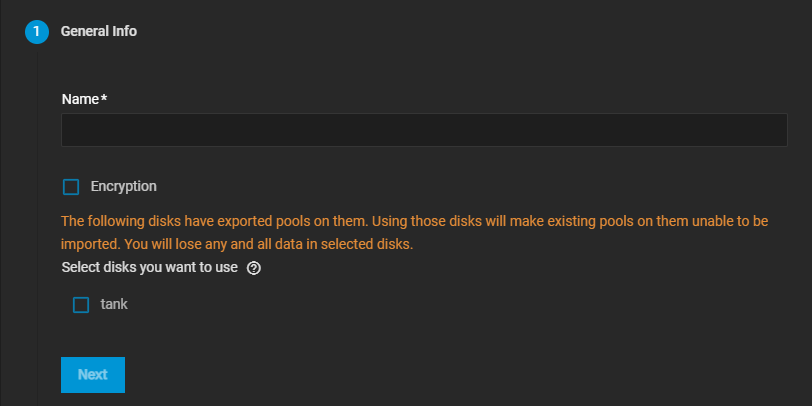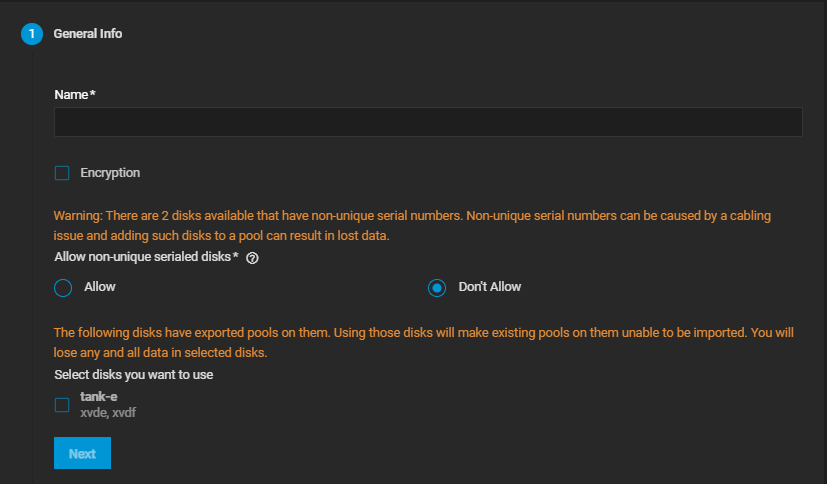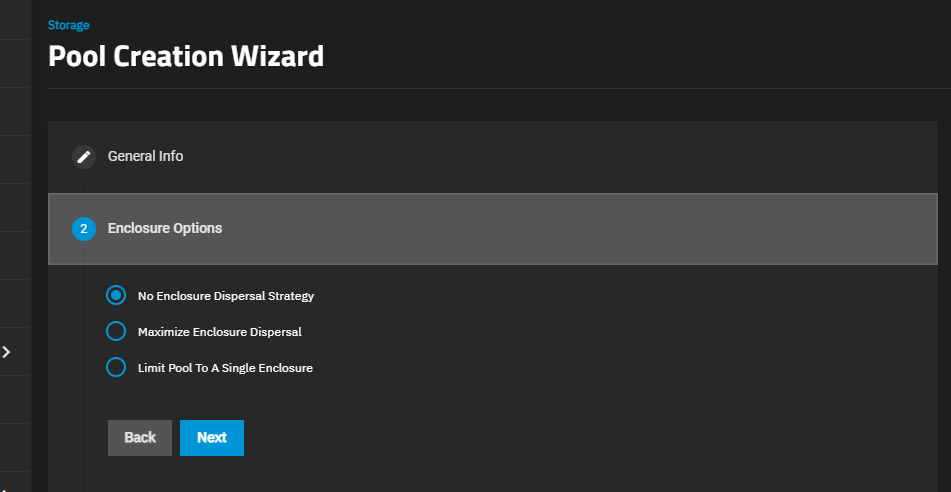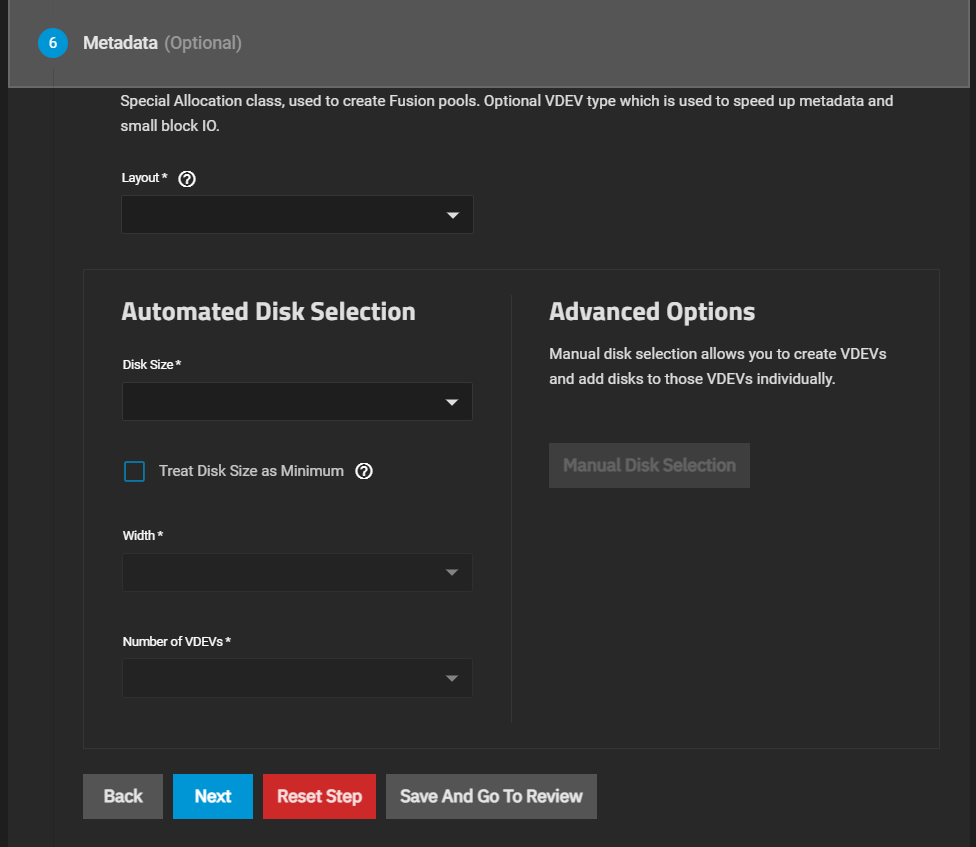Pool Creation Wizard
24 minute read.
The Pool Creation Wizard configuration screens include a configuration preview and an inventory list of disks available on the system.
Create Pool at the top right of the Storage Dashboard screen opens the Pool Creation Wizard.
Configuration Preview lists pool and VDEV settings that dynamically update as you configure settings in the wizard.
Inventory displays the number of available disks by size on the system, and this list dynamically updates as disks move to VDEVs added in the wizard.
The Pool Creation Wizard for most systems has seven configuration screens, numbered in sequence, to create a pool with VDEVs.
TrueNAS Enterprise
Larger iXsystems-provided servers for Enterprise users equipped with expansion shelves include the additional Enclosure Options screen.
Each wizard VDEV configuration screen includes the Automated Disk Selection and Advanced Options areas. Click Manual Disk Selection to open the Manual Selection screen.
Back and Next move to the previous or next wizard screen. Reset Step clears the VDEV settings for the VDEV type selected. For example, Data VDEV configuration. Save And Go To Review saves the current selections and goes directly to the Review wizard screen.
The General Info area includes two default settings, Name and Encryption.
Name is a required field. A pool name can have up to 50 characters and must follow ZFS naming conventions. Use lower-case alpha characters to avoid potential problems with sharing protocols. Names can include numbers and special characters such as underscore (_), hyphen (-), colon (:), or a period (.). Do not begin a pool name with a special character.
Encryption applies key-type encryption to the pool.
TrueNAS 22.12.3 or later forces encryption for all child datasets and zvols within an encrypted root or parent dataset that are using the TrueNAS UI. However, datasets created outside of the UI, such as those created programmatically or manually via shell access, might not inherit encryption unless properly configured. For more granular control and awareness, we do not recommend users configure pool-level encryption of the root dataset. Instead, create an unencrypted pool and populate it with encrypted or unencrypted child datasets, as needed.
Enables ZFS encryption for the pool and all datasets (or zvols) within the pool created using the TrueNAS UI. See Storage Encryption for more information on using TrueNAS storage encryption. An encryption warning dialog opens with a Confirm option. Confirm enables the I Understand button. I Understand continues with adding the pool with encryption applied.
Keep the encryption key file in a safe location where you perform regular backups. Losing the encryption key file results in lost data you cannot recover.
If system disks contain data exported from pools, a warning displays with a checkbox for the pool name.
If system disks have non-unique serial numbers, a warning displays with additional fields.
Allow non-unique serialed disks has two options, Allow and Don’t Allow.
Allow permits using disks with non-unique serial numbers, such as those that can occur on virtual disks. The Data wizard screen shows the disks as available. Don’t Allow does not permit using disks with non-unique serial numbers.
TrueNAS Enterprise
The Enclosure Options wizard screen shows if the Enterprise system has one or more expansion shelves.
The three radio button options apply a dispersal strategy that sets pool storage configuration topology. A dispersal strategy determines how the system adds disks by size and type to the pool VDEVs created when using the Automated Disk Selection option. Enclosures in the options below refer to the disk enclosures in the expansion shelves and system chassis.
No Enclosure Dispersal Strategy does not apply a dispersal strategy and does not show additional options. Disks added to the pool VDEVs are assigned in sequence based on disk availability but are not balanced across all enclosures.
Maximum Dispersal Strategy applies a maximum dispersal strategy, which balances disk selection across all enclosures and available disks. Does not show additional options. Disks added to the pool VDEVs are spread across all available enclosure disks.
Limit Pool To A Single Enclosure applies a minimum dispersal strategy. Shows the Enclosure dropdown with a list of available expansion shelf options. Disks added to the pool VDEVs are spread across the enclosure disks that align with the selection in Enclosure.
The Data wizard screen shows options to automatically or manually add disks to a data VDEV. A pool must have a data VDEV before you can add other types of VDEVs to the pool.
The Log wizard screen settings configure a log VDEV. ZFS log devices can improve the speeds of synchronous writes.
The Spare wizard screen settings configure a hot spare for a drive in a data VDEV.
The Cache wizard screen settings configure a ZFS L2ARC read-cache VDEV.
The Metadata wizard screen settings configure a special allocation class VDEV. Metadata VDEVS are used to speed up metadata and small block I/O. Use when creating a fusion pool.
The Dedup wizard screen settings configure a deduplication VDEV. A Dedup VDEV stores de-duplication tables. Size dedup VDEVs as x GiB for each x TiB of general storage.
The Manual Selection screen shows settings to add a Data VDEV Layout and the individual disks available to add to the new VDEV. You can filter disks by type or size.
Add places a VDEV area to populate with individual disks.
The screen shows disk icons for available disks. The system dropdown list also shows a list of available system disks. Use the disk filters separately or together to find disks of the same type and size. Drag disks to the VDEV to add them.
Save Selection creates the VDEV and closes the window.
| Setting | Description |
|---|---|
| Search | Enter the disk name or other details to search for disks matching the specified value to filter available disks in the system. |
| Filter by Disk Type | Resets the available disks listed to show only the selected type (HDD or SSD). |
| Filter by Disk Size | Resets the available disks listed to show only disks matching the selected size. |
| TrueNAS System | Click to expand and show the list of available disks in the system. Filter options change disks displayed on this list. |
The Review wizard screen shows a summary of VDEVs in the pool configuration.
Inspect VDEVs opens the Inspect VDEVs screen that shows the VDEVs with assigned disks added to the pool.
Start Over clears the current pool configuration so you can start over.
Create Pool completes the configuration process and adds the pool.

















